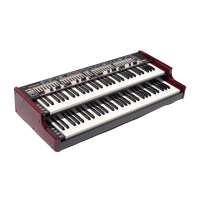14 | Nord C2d User MaNUal os v1.X
Vibrato
The original vibrato and chorus scanner in a
tonewheel organ consists of a tapped delay
line in combination with a rotating scanner.
For the Vibrato effect, phase shift is applied
to the signal. For the Chorus effect, the phase
modulated signal is added with the original
signal.
Three different types of choruses (C1 - C3) and three different types of
vibratos (V1 - V3) are available. Select one of these types by press-
ing the Mode button. The effect can be activated/deactivated for both
manuals individually by pressing the Vibrato/Chorus button for the swell
and great manuals.
Please note that the Vibrato/Chorus button for the great manual also
controls this effect for the tonewheel pedal registers.
Key click control
The key click produced by the random contact bounces is an impor-
tant audio artifact. This quickly became a desirable effect amongst
musicians. You can adjust the click level in the Sound menu, read more
about this on page 20.
Do not forget to try out the four tonewheel modes that are avail-
able in the Sound menu. These will dramatically change the sound
of the B3 model from squeaky clean to a battered, old work horse.
The VX Model
The original Vox™ organ is probably the most famous of all the
transistor-based combo organs that emerged in the early 60’s. Transis-
tor technology made it possible to manufacture much more compact
and portable organ instruments. Compared to the mighty sound of
tonewheel based organs, transistor organs generally sounded reedier
and weaker, but this one had a distinctive sound character which
together with the portability and cool design (inverse colored keyboard
and chrome “Z-frame” stand) made the instrument massively popular
at the time. The sound is timeless and recreated faithfully in Nord C2D.
The Drawbars
The labels used for the VX drawbars are printed on the row directly
above the drawbars.
For basic drawbar operation, please look at page 12.
The seven drawbars to the left control the level of each partial. Each
partial has a fixed harmonic interval relating to the played note. The
illustration below shows the pitch interval of the drawbars when the key
of C3 is played. The intervals vary for the upper and lower manual on
the original instrument, but are identical on the Nord C2D.
The two right drawbars control the sum of all partials in the form of a
filtered signal sounding soft and dark, and an unfiltered signal sounding
bright and intense.
E If these two drawbars are both fully pushed in, the manual will not
produce any sound.
Vox Vibrato
There are several types of vibrato and choruses available for the VX
model, which is activated using the Swell/Great buttons in the Vibrato
section. The V3 setting is the one that is modeled after the original
instrument.
M The VX models vibrato setting is common for both the swell and
great manual.
The Farf Model
This typical “buzzy” sound of this vintage instrument is one of the most
distinct and easily recognizable organ sounds ever created, yet it is
actually possible to get quite a wide range of sounds out of the instru-
ment. Note that the voices aren’t supposed to replicate the instruments
they are named after, but rather to describe the basic tonal characteris-
tic of the voice; Flute - soft, Oboe - reedy, Trumpet - brassy.
The Register selectors
The labels used for the Farf drawbars are printed above the drawbars.
The drawbars act as on/off switches, or “register selectors” when the
Farf model is selected. The original instrument featured “rocker”-type
switches select instrument “voices” (actually different filter settings) in
various footage (octave) ranges. The drawbars are used to turn voices
on and off. The table below shows the original register name.
Upper
Lower
C3

